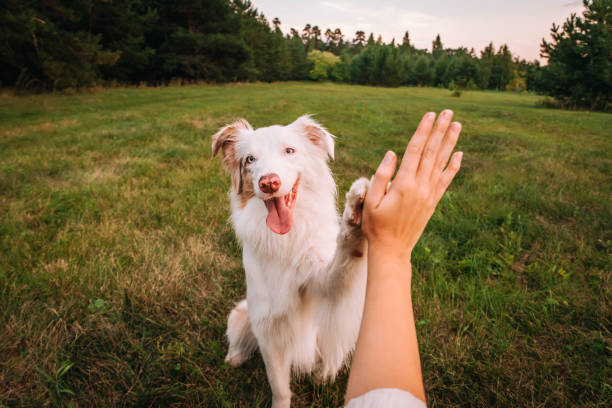
Dog gives paw to a woman making high five gesture
Every dog craves balance. Just like humans, dogs find comfort in predictability—knowing when they’ll eat, walk, play, and rest. This rhythm gives them confidence and helps them feel secure in their world. When owners establish structure, training becomes easier, and the bond between human and dog grows stronger.
Training a dog isn’t about strict control; it’s about building mutual understanding. It’s a slow and rewarding process where patience, consistency, and compassion matter more than perfection. Whether you’ve got a high-energy puppy or a calm older companion, structure is the key to creating a well-adjusted pet.
Why Routine Matters in Dog Training
Dogs are creatures of habit. When their days follow a pattern, they know what to expect and how to behave. This predictability reduces anxiety and confusion—two of the biggest obstacles in training.
Imagine waking up every day without knowing when you’ll eat or go outside—it would be stressful. The same is true for dogs. A set schedule helps them regulate behavior and respond better to cues. They quickly learn when it’s time to walk, play, or rest, which means fewer unwanted behaviors like barking or chewing from boredom.
The Role of Consistency
Consistency is the foundation of effective training. Dogs learn through repetition, and every time we change our tone, command, or timing, we send mixed messages. For example, if “off” sometimes means “stop jumping” and other times means “get down from the couch,” the dog won’t know which behavior you’re correcting.
That’s why using the same words, gestures, and reactions helps your dog understand faster. Over time, consistency builds trust—your dog learns that your signals are reliable and that good behavior always leads to positive outcomes.
Many trainers who specialize in programs like dog training Katy TX emphasize that consistent communication and daily structure can turn even the most energetic or stubborn dogs into well-behaved companions. When owners follow clear patterns, dogs become calmer and more cooperative.
Positive Reinforcement Builds Motivation
Reward-based training works best when it’s part of a consistent daily routine. When a dog knows that calm behavior or obedience earns praise, treats, or play, they naturally want to repeat that action.
For example, a simple “sit” before meals teaches impulse control and patience. A quick “come” command during play builds recall skills. When you reward good choices regularly, your dog learns not just commands but emotional control.
Patience is crucial. Every dog learns differently. Some pick up new skills in days, while others need weeks of repetition. What matters most is maintaining a calm, encouraging tone and celebrating small successes.
Adapting Routine for Puppies and Adults
Puppies require structure from day one. Frequent potty breaks, meal schedules, and short, fun training sessions create the foundation for good habits. Puppies who grow up with predictable routines are easier to manage as adults—they’re more confident and less reactive to new situations.
Adult dogs, especially rescues, might need time to adjust to structure. If they’ve experienced instability before, routines give them the security they’ve been missing. Start simple: feed them at the same time daily, go on walks at consistent hours, and introduce short training moments throughout the day. With time, they’ll relax into the rhythm and start responding more naturally.
Mental Stimulation Is Just as Important
Training isn’t only physical—it’s mental exercise too. Dogs need challenges that keep their brains active. Puzzle toys, scent games, or short obedience drills all help maintain focus and reduce boredom. Mental engagement prevents behavioral problems like digging, excessive barking, or chewing furniture.
You can incorporate mental stimulation into daily routines easily. Hide treats around the house, practice commands during walks, or let your dog “work” for their meals through simple problem-solving games. These activities provide enrichment and satisfaction, keeping your dog calm and balanced.
The Importance of Calm Energy
Dogs are highly attuned to their owner’s emotions. If you’re calm, they’re calm; if you’re tense, they mirror that energy. That’s why staying relaxed during training sessions is so important.
When things don’t go perfectly, take a break instead of reacting with frustration. Training should be a positive experience for both of you. Remember, progress often comes in small, steady steps, not big leaps.
A calm mindset also helps with leash walking, greeting visitors, and managing distractions. Your dog will look to you for cues—if you remain steady, they’ll follow your lead.
Integrating Training into Everyday Life
Training shouldn’t be limited to specific sessions; it works best when woven naturally into daily routines. Asking your dog to “sit” before going outside, “wait” before meals, or “come” during playtime reinforces learning in real situations.
Repetition in real-life contexts helps your dog generalize commands. Instead of only obeying indoors or during class, they begin responding in any environment—whether at home, the park, or on a busy street.
The Emotional Side of Training
Training does more than create obedience—it strengthens emotional bonds. Every shared moment of success deepens trust and communication. When your dog learns from your calm, patient guidance, they begin to see you as both leader and companion.
This emotional connection also encourages better behavior long-term. A dog who trusts their owner wants to please them, even when treats aren’t involved. That’s the difference between temporary obedience and lasting partnership.
Final Thoughts
Training a dog is never just about commands—it’s about connection, rhythm, and understanding. The more consistent and patient you are, the more confident your dog becomes. Routines give structure to their world and meaning to your bond.
Every meal, walk, and quiet moment becomes part of the learning process. Over time, these small acts of consistency shape a calm, obedient, and emotionally balanced dog. Training isn’t about perfection—it’s about progress built through patience and trust.
When we slow down and commit to the process, we don’t just create better-trained dogs—we create stronger, happier relationships that last a lifetime.



